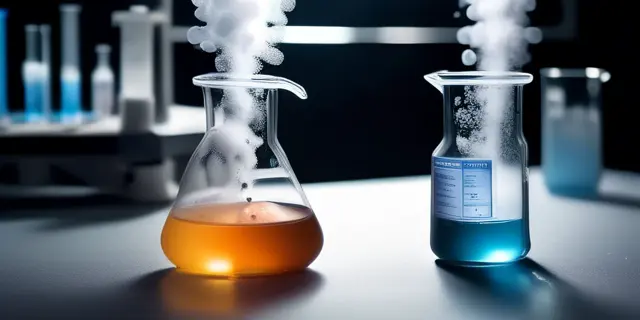🔥 Introduction: What Happens When Sodium Hydroxide Reacts with Sulfuric Acid? {#introduction}
When sodium hydroxide (NaOH), a strong base, reacts with sulfuric acid (H₂SO₄), a strong acid, the result is a neutralization reaction. In this process, the acid and the base combine to produce water and salt. Understanding this reaction is fundamental to both introductory chemistry and its real-world applications.
But the burning question is: What salt is produced when sodium hydroxide reacts with sulfuric acid?
🧪 The Chemical Reaction: Understanding the Basics {#chemical-reaction}
The reaction between sodium hydroxide and sulfuric acid is an example of a neutralization reaction, where an acid and a base react to form a salt and water. The general form of the response is:
H₂SO₄ + 2NaOH → Na₂SO₄ + 2H₂O
In this equation:
- Sodium hydroxide (NaOH) donates hydroxide ions (OH⁻).
- Sulfuric acid (H₂SO₄) donates hydrogen ions (H⁺).
- Sodium sulfate (Na₂SO₄), the salt, is produced along with water (H₂O).
This is a typical acid-base reaction where the base neutralizes the acid, forming salt and water.
💡 What Salt Is Produced in This Reaction? {#salt-produced}
When sodium hydroxide reacts with sulfuric acid, the salt produced is sodium sulfate (Na₂SO₄).
- Sodium sulfate is an inorganic compound commonly used in detergents, textiles, and paper production.
- The reaction also produces water as a byproduct, typical of neutralization reactions.
The sodium sulfate formed is a neutral salt, meaning it does not affect the pH of the solution once dissolved in water.
🔬 The Role of Sodium Hydroxide and Sulfuric Acid {#role-of-chemicals}
Sodium Hydroxide (NaOH):
- Sodium hydroxide, or lye or caustic soda, is a strong base widely used in soap-making, cleaning agents, and chemical manufacturing industries. It is highly corrosive and should be handled with care.
- In a neutralization reaction, sodium hydroxide donates hydroxide ions (OH⁻) that neutralize the hydrogen ions (H⁺) from the sulfuric acid.
Sulfuric Acid (H₂SO₄):
- Sulfuric acid is a strong acid commonly used to produce fertilizers, chemicals, and refined petroleum. It is highly concentrated and should be handled cautiously due to its corrosive nature.
- In the reaction with sodium hydroxide, sulfuric acid donates hydrogen ions (H⁺) that interact with the hydroxide ions to form water.
🌍 Applications of Sodium Hydroxide and Sulfuric Acid Reactions {#applications}
The reaction between sodium hydroxide and sulfuric acid has several practical applications in various industries:
- Manufacturing of sodium sulfate: Sodium sulfate is used to produce detergents, textiles, and paper.
- Wastewater treatment: Sodium hydroxide is commonly used in water treatment plants, and the neutralization of sulfuric acid is an essential process in such settings.
- Chemical production: The reaction also synthesizes various other chemicals and compounds used in pharmaceuticals, plastics, and paints.
⚠️ Important Considerations When Handling Sodium Hydroxide and Sulfuric Acid {#considerations}
Both sodium hydroxide and sulfuric acid are highly corrosive and can cause serious harm if not handled properly. Here are some safety tips:
- Wear protective equipment: Always wear gloves, goggles, and protective clothing when working with these chemicals.
- Work in a well-ventilated area: Both chemicals release fumes irritating the respiratory system.
- Handle with care: Add acid to water, never water to acid, to avoid exothermic reactions that can cause splattering.
❓ Questions and Answers {#qa}
Q: What salt is produced when sodium hydroxide reacts with sulfuric acid?
A: The salt produced is sodium sulfate (Na₂SO₄) and water (H₂O) as a byproduct.
Q: Why is sodium sulfate formed in this reaction?
A: Sodium sulfate is formed because sodium ions (Na⁺) from sodium hydroxide combine with sulfuric acid’s sulfate ions (SO₄²⁻), resulting in the neutral salt sodium sulfate.
Q: What happens if sodium hydroxide reacts with sulfuric acid in excess?
A: If sodium hydroxide is in excess, the reaction will continue until all the sulfuric acid is neutralized, and the solution will become basic due to the leftover hydroxide ions.
Q: What are the uses of sodium sulfate in industry?
A: Sodium sulfate is a byproduct of various industrial processes and is used in detergents, textiles, and paper manufacturing.
Read More : 10 Surprising Ways How You Get Bed Bugs in the First Place: A Complete Guide
✅ Conclusion: The Salt Produced and Its Importance {#conclusion}
The reaction between sodium hydroxide and sulfuric acid is a classic neutralization reaction that produces sodium sulfate (Na₂SO₄) and water. Understanding this reaction not only helps in fundamental chemistry but also provides insights into the industrial applications of the resulting salt. Sodium sulfate plays a significant role in various industries, and the reaction between these two chemicals is an essential process in many chemical manufacturing procedures.
By learning the chemical equation and understanding the process, you can better appreciate how acids and bases interact to produce valuable compounds in real-world applications.


1 Comment
Pingback: How Can I Stop a Rug Moving on Carpet? 7 Simple Solutions to Keep Your Rug in Place - BritPulse